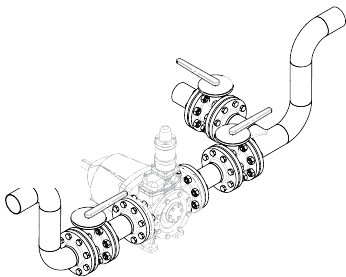
33
A.0500.551 – IM-TGMAG/02.00 EN (02/2008)
3.18.5.2 Piping
• Use piping with a diameter equal to or greater than the connection ports of the pump and with
the shortest possible lengths.
• Thepipediameterhastobecalculatedinfunctionoftheliquidparametersandtheinstallation
parameters. If necessary use larger diameters to limit pressure losses.
• Iftheuidtobepumpedisviscous,pressurelossesinthesuctionanddischargelinesmay
increase considerably. Other piping components like valves, elbows, strainers, filters and foot
valve also cause pressure losses.
• Diameters,lengthofpipingandothercomponentsshouldbeselectedinsuchawaythatthe
pump will operate without causing mechanical damage to the pump/pump unit, taking into
account the minimum required inlet pressure, the maximum allowable working pressure and the
installed motor power and torque.
• Checkthetightnessofthepipesafterconnection.
Suction piping
• Liquidsshouldenterthepumpfromalevelhigherthanthepumplevel,theincliningpipeshould
rise upwards towards the pump without any air pockets.
• Atoosmalldiameteroratoolongsuctionpipe,atoosmallorblockedstrainerwillincrease
pressure losses so that the NPSHa (NPSH available) becomes smaller than the NPSH (NPSH
required).
Cavitation will occur, causing noise and vibrations. Mechanical damage to pump and pump unit
may occur.
• Whenasuctionstrainerorlterisinstalledpressurelossesinthesuctionlinemustbechecked
constantly. Also check if the inlet pressure at the suction flange of the pump is still sufficiently
high.
Self-priming operation
At the start sufficient liquid must be available in the pump filling up the internal clearance volume and
the dead spaces, allowing the pump to build up a pressure difference.
Therefore, for pumping low viscosity fluids, a foot valve with the same or larger diameter than the
suction pipe must be installed or the pump can be installed without foot-valve but in U-line.
Note! A foot valve is not recommended when pumping high viscous liquids.
• Toremoveairandgasesfromsuctionlineandpump,counterpressureatthedischargeside
must be reduced. In case of self-priming operation, start-up of the pump should be performed
with open and empty discharge line allowing air or gases to escape at low backpressure.
• Anotherpossibilityincaseoflonglinesorwhenanon-returnvalveisinstalledinthedischarge
line, is to install a by-pass with isolating valve close to the discharge side of the pump. This valve
will be opened in case of priming and allows air or gas evacuation at low backpressure.
• Thebypassshouldbeleadbacktothesupplytank–nottothesuctionport.
3.18.5.3 Isolating valves
To allow proper maintenance it is necessary to be
able to isolate the pump. Isolation can be done by
installing valves in suction and discharge lines.
• Thesevalvesmusthaveacylindricalpassageof
the same diameter of the piping (full bore). (Gate
or ball valves are preferable).
• Whenoperatingthepump,thevalvesmust
be opened completely. The output must never
be regulated by means of closing valves in
suction or discharge pipes. It must be regulated
by changing shaft speed or by re-routing the
media over a by-pass back to the supply tank.
Discharge
By-pass
Piping
Suction


















